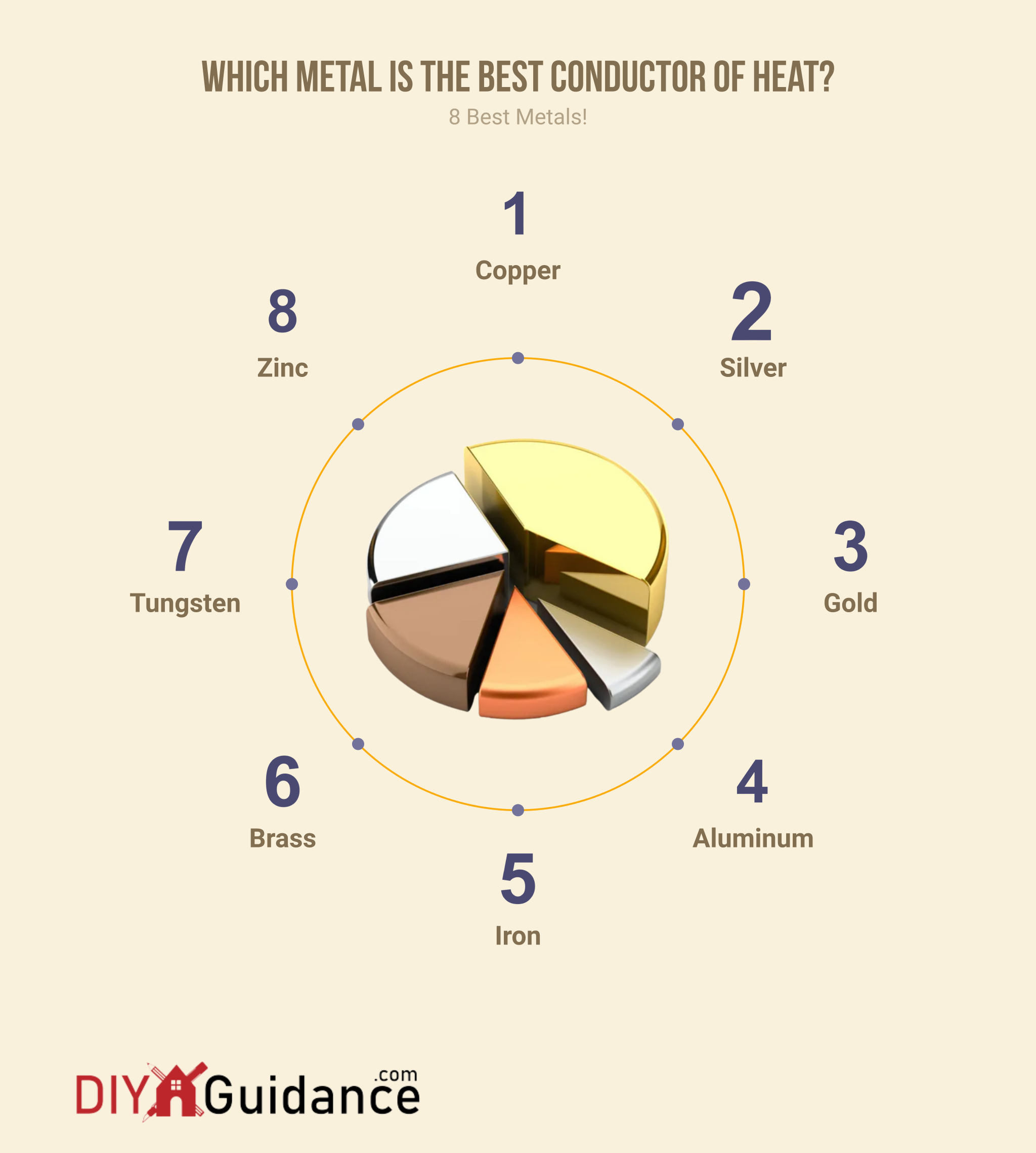Most of our everyday metal products and appliances need heat conductivity to function. From heaters to cookware — these are among the things that run at high temperatures. Knowing which metal is the best conductor of heat is crucial if you’re looking to tackle a DIY project that needs to conduct, carry, and transfer heat well.
So, read on if you’re searching for the best metal heat conductors available!
What is a Heat Conductor? (Heat Conduction Explained)

Transferring is possible through three methods: radiation, convection, and conduction. Among the three, conduction is the most flexible and standard as it often happens in nature. Generally, heat conduction is the transfer of high temperatures via physical contact.
For instance, heat conduction happens when you place your palm onto a window pane or place a pot of water on a stove. And though we can see the water boil, the actual heat transfer happens at a molecular level. When the heat energy gets absorbed by a surface, the molecules in that area will move faster. As a result, they’ll bump into other particles, transferring energy to them.
That process will continue as more heat gets added to the surface. But regardless of the heat conductors used, the process depends on four factors:
Temperature Gradient
It’s a physical quantity describing the temperature’s direction and the rate at a specific location. Remember, the temp will always flow from the hottest sources to the coldest. After all, “cold” refers to the absence of heat in an area.
Regardless, the transfer between bodies will continue until the temp difference decays. And once this occurs, a state dubbed “thermal equilibrium” will appear.
Cross-section & Path Length
Of the four crucial factors included in heat conduction, cross-section and path length go hand in hand. After all, the greater the material’s size included in the transfer, the more heat it needs to warm up. Aside from that, the more exposure to open air a surface area has, the higher the possibility of heat loss.
In short, shorter items with a more narrow cross-section and path length are the best at heat conduction. After all, they reduce heat energy loss by a mile!
Material (Physical Property)
Finally, the last essential factor is the physical properties of the materials used. Note that no substances are equal regarding conducting heat! Because of this, many consider metals one of the best conductors of heat as they can do it fast and efficiently.
Why Are Metals That Conduct Heat Well Important?
Each metal has unique properties, letting them conduct heat differently. Hence, they fulfill different intentions and purposes across various products. So, you can see why it’s essential to look at each metal before deciding which to use for your next DIY project. For instance, water heaters conduct heat differently than electronic appliances.
If you’re still unconvinced about the importance of heat conductive metals, here are more applications you can explore with them:
Heat Exchanger
Heat exchangers are where metals must transfer heat well to achieve optimal heating or cooling. Generally, copper and aluminum are the best metals for this application. After all, they boast excellent thermal conductivity, allowing heat to go through fast:
Usually, you’d find heat exchangers in these facilities and products:
- Industrial structures
- Solar systems
- Thermal systems
- Water systems
- Gas systems
- Air heating or cooling systems
Heat Sink
A heat sink is a specific heat exchanger that lets heat flow into moving coolant fluids well. It enables the device to cool down to its desired temperatures ASAP! And you’d typically find heat sinks in LEDs, lasers, power transistors, and computers.
Generally, heat sinks consist of aluminum or aluminum alloys. After all, this metal absorbs and transfers heat fast, is easy to form, and is cheap.
Cookware
Finally, the most common application of great metal heat conductors is cookware. After all, you’ll need a metal that can heat up fast and retain the high temp on its surface for as long as necessary. How else would you be able to sear, grill, fry, or broil your food?
You’ll find these metals in pots, pans, fryers, and other kitchen items you often use. Generally, most cookware uses aluminum, which heats up fast and can spread across the surface. As a result, you’ll be able to cook your food at your desired temperatures for as long as you need.
Which Metal is the Best Conductor of Heat?

🔥 Copper
Copper is the best metal heat conductor as it can absorb heat fast and hold it the longest! That’s why top-quality cookware and electrical appliances often use copper. But copper is also very durable, aside from absorbing and retaining heat well. It’s a corrosion-resistant metal, handling most harmful chemicals well.
Moreover, copper is more affordable than other metal heat conductors like gold. With its low price tag, you can do more DIY projects without breaking the bank! No wonder companies use copper to create mass-produced items, such as cookware.
Aside from cookware, you can also use copper for heating systems and car and computer parts.
🔥 Silver
Silver has become one of the best metals for heat conduction due to its one-of-a-kind crystal structure, the single valence electron, and reflectivity. But as efficient as this metal is, silver is an expensive material, making it not the best pick for commercial or mass-produced products.
Aside from that, silver is also softer than other metals and tarnishes fast, making it hard to mold! So, it’s easy to see why we can only spot silver in specialized equipment or products.
Generally, you’d find this metal in circuit boards, batteries, or satellites.
🔥 Gold
Gold is among the best conductors of heat; unlike silver, it’s easier to handle! It doesn’t tarnish as fast, and even inexperienced hands can shape the metal well in no time. Moreover, gold can handle high temperatures; if heated quickly enough, it can go hard instead of melting!
Also, gold is incredibly durable, boasting a corrosion-resistant build, allowing it not to wear out as fast as other metals. And with all these excellent properties, it’s no wonder gold is expensive! So, it’s not surprising you wouldn’t see this metal in everyday goods.
But it’s possible to see small amounts of gold in specialty gadgets, medical equipment, or aerospace technology!
🔥 Aluminum
Although not nearly strong and heat conductive as copper, aluminum is still one of the best. This metal has excellent thermal conductivity, heating up fast and maintaining it for a long time. But aluminum is better than copper because it’s cheaper and recyclable!
Aluminum is among the few metals that you can recycle again and again without it losing its mechanical and chemical properties over time. So, it’s not surprising to see aluminum become one of the most common metals used for commodity items like cookware.
Aside from cookware, you can also see aluminum in wires and heat sinks. Regardless of the application, this metal allows people to control heat better, preventing overheating!
🔥Iron
Cast iron is a decent heat conductor that can hold heat well for a while. But it isn’t as good as the top metals like copper and aluminum. So, you’ll likely only see iron in low-end or cheaper products.
Still, that doesn’t mean this metal isn’t contributing to improved heat conduction. Opt for iron if you want to test a DIY idea before going all in.
🔥Brass
If you’re looking for a heat-conductive metal that’s also tough and durable, brass is your best bet! It’s one of the strongest metals, combining copper and zinc, boasting incredible toughness. And thanks to this, brass can handle temperatures as high as 900℃!
Brass has become common in applications that need strong heat conductivity and strength. So, you’ll often find this metal in pipes, electrical plugs, valves, and sockets.
🔥 Tungsten
Tungsten is famous for its excellent heat conductivity and low vapor pressure. It’s the best metal for applications involving frequent electricity and heat exposure. Aside from that, tungsten is chemically inert, meaning electrical currents can go through it without getting damaged!
So, tungsten is standard in lightbulbs, cathode-ray tubes, and electrodes. The metal helps these advanced tools carry electricity well while protecting them from overheating!
🔥 Zinc
Finally, choose zinc if you want to tackle a budget-friendly DIY project involving heat conduction. Although it’s not as heat conductive as the other metals, it’s an excellent affordable alternative.
Making up for its below-average thermal conductivity is its durability and flexibility!
What are Other Thermally Conductive Materials?

Although metals are among the best conductors of heat available, there are a few materials that can be up to par! Check out these five alternatives to metal heat conductors:
💎 Diamond
Diamond is the best heat conductor and is above copper. Its conductivity values surpass the popular metal 5x!
It’s all possible thanks to diamond atoms containing a simple carbon backbone. That’s the ideal molecular structure for flawless heat transfer!
Generally, materials with straightforward compositions and molecular structures have the best heat conductivity. And Diamonds are crucial components presenting modern hand-held gadgets!
This expensive material facilitates heat dispersion in electronics, protecting sensitive parts. Moreover, the diamond’s excellent thermal conductivity helps determine jewelry authenticity. And adding small amounts of this precious gem into equipment and technologies can bring their thermal conductivity properties to the next level!
📟 Aluminum Nitride
Beryllium oxide is a non-metal heat conductor that imposes health hazards on users. So, as an alternative, you can use aluminum nitride. Many use this material to replace beryllium oxide as they have similar chemical and physical properties, with the difference being this one doesn’t impose any health hazards!
Aside from being an excellent conductor of heat, aluminum nitride also offers excellent electrical insulation. As a result, this material also boasts thermal shock resistance, making it an excellent insulator in mechanical chips!
🔋 Graphite
Compared to most carbon allotropes, graphite is the cheapest and lightest conductor of heat. As a result, many use this material alongside polymer mixtures to improve heat conductivity. For instance, you’ll find this material in batteries, preventing them from overheating.
🚗 Silicon Carbide
When you combine a balanced mixture of carbon atoms and silicon, you get silicon carbide, an excellent semiconductor of heat! Aside from that, it also boasts incredible hardness and toughness, making it a common material for carb brakes, steel mixtures, and turbines.
🌡️ Mercury
Mercury boasts high thermal conductivity, making it an excellent alternative. And aside from that, it can also hold low boiling points, making it suitable for measuring high temperatures! Combined, it’s no wonder many use mercury in different applications. But generally, you’d find this material in measuring devices.
Frequently Asked Questions
Q: Which metal is the best conductor of heat and can keep it for a while?
A: The best metal heat conductor is copper, boasting high thermal conductivity. Copper is so brilliant at conducting heat that it works well for heat exchanges. Meanwhile, the worse metals for heat conduction are steel and bronze. Unlike copper and other metals like aluminum, those two have low thermal conductivity.
Q: Which metal can hold heat the longest?
A: Stainless steel holds high temperatures the longest, displaying the most thermal inertia. Other great contenders are copper, alloy, aluminum alloy, and cast iron. Meanwhile, the metal that loses heat the quickest is aluminum. With that, aluminum is one of the best metals you can join without welding, as it doesn’t keep the heat for long.
Q: Is metal the best heat conductor?
A: Since metals have free electrons that aren’t attached to atoms, they can transfer heat well. Their composition lets those atoms roam and collide with others while transferring heat. As a result, metals have become among the best conductors of heat than other materials.
Q: Are all metals excellent heat conductors?
A: All metals are capable heat conductors but not each one can perform as well as the other. For instance, aluminum has low thermal conductivity than copper. Hence, it’s not the best choice for heat conduction. Still, all metals are more reliable conductors than most materials.
Q: What metal is the worst heat conductor?
A: The poorest conductor of heat is lead, as it can emit lead oxide fast. And we all know that metal oxides aren’t the best conductors of heat. The metal displays low thermal conductivity as lead oxide interacts with the environment.
Final Words
All metals are excellent heat conductors, but some are better than others. So, you can see why knowing which metal is the best conductor of heat essential for DIY projects. Generally, copper and aluminum are at the top, boasting high thermal conductivity. But remember, all metals have unique properties, working better on specific applications than the rest. So, search carefully for the best metal for your next project!


